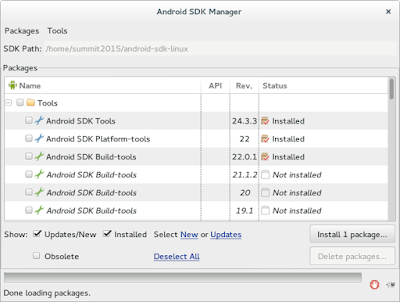I wanted to display my Android screen on Fedora during a Summit presentation which includes Feedhenry. I found an easy way to mirror my android screen on Fedora so I can show it through the presentation device (TV, Projector, etc.). So I compiled the steps below from some different references.
List of devices attached
0A3D267016016004 device
[summit2015@localhost platform-tools]$
NOTE: I ran android update adb and adb server-start to test prior to the above command but these shouldn't be required
- Download the latest Android SDK from Google: Android SDK
- Extract the TGZ file to your home/YOUR-USERNAME directory
- To get ADB, you need to install the SDK: Installing the SDK
- Run chmode on android in tools
- Run android under tools and then install the Android SDK Tools
- On your phone turn on Debugging in Developer Settings, click Settings > Developer Options turn on debugging and make sure USB Debugging is on.
- If you are running 64-bit then to run adb you will have to enable 32-bit
- # yum install glibc.i686
- #yum install zlib.i686 libstdc++.i686 ncurses-libs.i686 libgcc.i686
- You need to add a
udevrules file that contains a USB configuration for each type of device you want to use for development. In the rules file, each device manufacturer is identified by a unique vendor ID, as specified by theATTR{idVendor}property. For a list of vendor IDs, see USB Vendor IDs, To set up device detection on Linux: - Log in as root and create this file:
/etc/udev/rules.d/51-android.rules.
Use this format to add each vendor to the file:
SUBSYSTEM=="usb", ATTR{idVendor}=="xxxx", MODE="0666"
[summit2015@localhost tools]$ cat /etc/udev/rules.d/51-android.rules
SUBSYSTEM=="usb", ATTR{idVendor}=="22b8", MODE="0666"
[summit2015@localhost tools]$
Note: The rule syntax may vary slightly depending on your environment. Consult theudevdocumentation for your system as needed. For an overview of rule syntax, see this guide to writing udev rules. - Now execute:
chmod a+r /etc/udev/rules.d/51-android.rules
- When plugged in over USB, you can verify that your device is connected by executing adb devices from your SDK platform-tools/ directory. If connected, you'll see the device name listed as a "device."
List of devices attached
0A3D267016016004 device
[summit2015@localhost platform-tools]$
NOTE: I ran android update adb and adb server-start to test prior to the above command but these shouldn't be required
That's all that is required!
References:
http://unix.stackexchange.com/questions/57863/how-to-run-32-bit-programs-on-64-bit-fedora-17
References:
http://unix.stackexchange.com/questions/57863/how-to-run-32-bit-programs-on-64-bit-fedora-17




